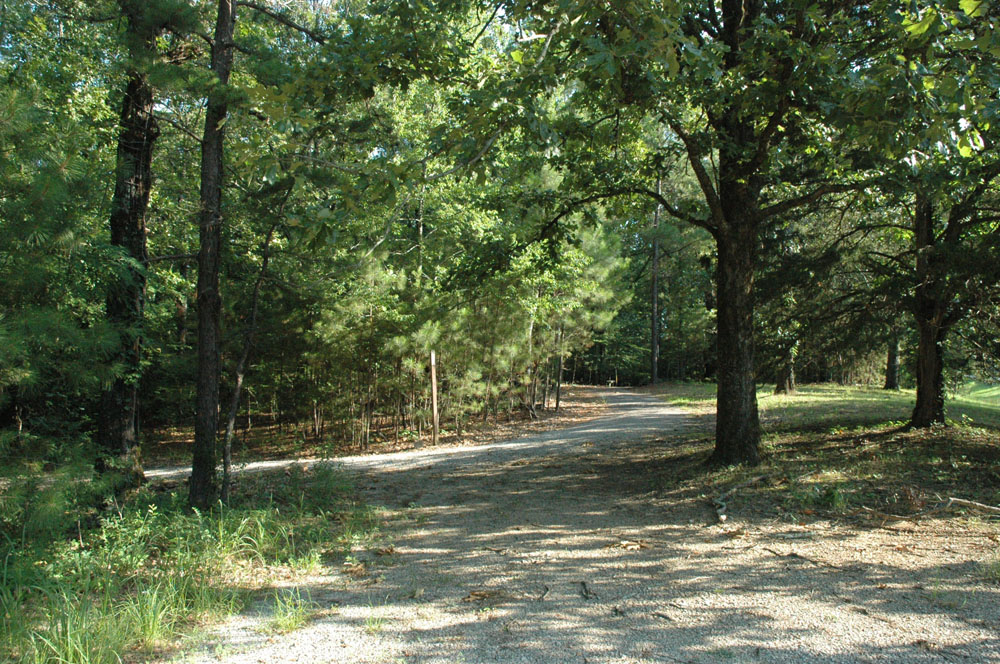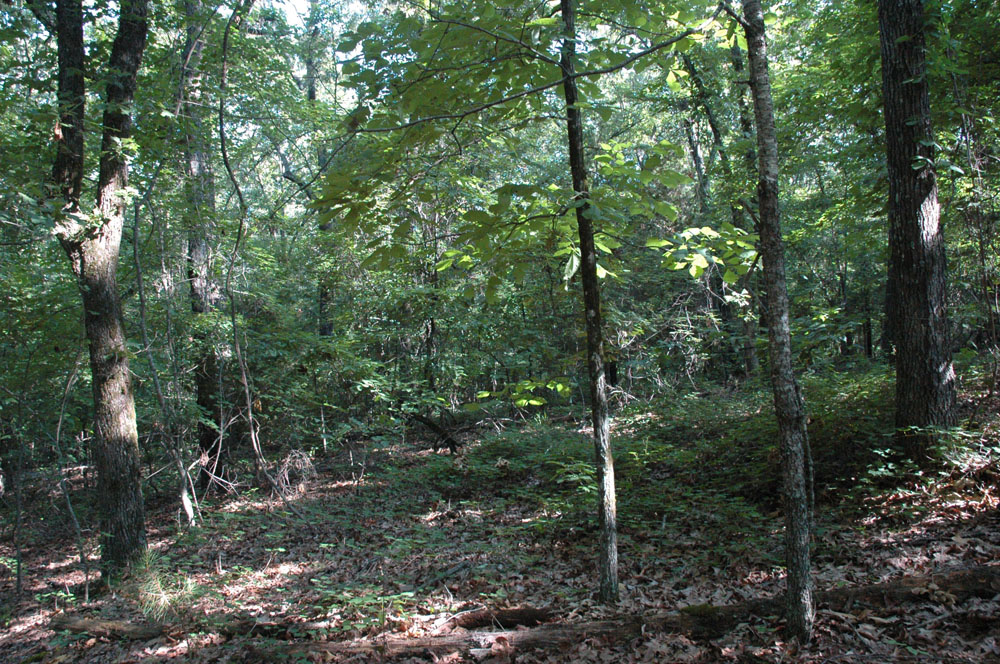Ants in John W. Kyle State Park and Sardis Lake, Panola County, Mississippi
[MS State Park Ants]
Joe A. MacGown, uploaded on 19 July 2011
John W. Kyle State Park is located in Sardis in Panola County, Mississippi about 8 miles down Highway 315 South off of I-55. The park is situated on the Sardis Reservoir, and as such, is geared toward fishing and water sports. Cabins are available in the main part of the park on the upper lake, and camping is available on the lower lake.

A view of the lake edge just behind the cabins
On 29 and 30 June 2011, I collected ants in the park near the cabin area (34°25'30"N89°48'01"W) and along the fitness/nature trail in the adjacent Corps of Engineers operated Sardis Lake Recreational Area (34°23'32"N89°47'00"W). The state park and Sardis Lake R. A. are intertwined and are essentially the same habitat and locality. The wooded areas around the lake are predominately deciduous to mixed pine/hardwood. Surrounding the lake are sandstone formations and some sandy areas. Cypress trees were common in low wet areas around the lake. In higher areas near the cabin, the forest was mixed cedar/hardwood forest with a grassy understory.

The nature/fitness trail located before the levee.
I arrived at the park mid to late afternoon on the 29th after first having collected and explored in Holly Springs National Forest. I was able to snag a cabin, so I decided to spend the night. It really was not hard to get a cabin, as all the cabins were open. I pasted some peanut butter on trees around the cabin to see what species of ants might show up. It was not long before Forelius mccooki, Monomorium minimum, Solenopsis carolinensis, and Temnothorax schaumii showed up at the bait. Scattered colonies of the hybrid fire ant Solenopsis invicta x richteri were present. Forelius mccooki colonies were numerous in the upper, open dry areas near the cabins, and among the few species that were active in the heat of the day. Down lower, on the upper edges of a sand bar, colonies of Dorymyrmex bureni were seen in abundance. Three species of carpenter ants, Camponotus americanus, C. chromaiodes, and C. pennsylvanicus were collected on trees and crawling on the ground. At approximately 6 PM, a large grouping of C. pennsylvanicus was observed on a cypress. Foragers of Formica pallidefulva were observed and collected, although colonies were not detected. I found colonies of Nylanderia vividula and Lasius alienus at bases of trees as I walked up a hill toward the cedar/hardwood forest. Colonies of the ubiquitous fungus growing ant, Trachymyrmex septentrionalis, were scattered along the hillside. Two species of Aphaenogaster, A. fulva and A. lamellidens and three species of Crematogaster, C. ashmeadi, C. lineolata, and C. vermiculata were collected in the area.
I collected litter samples at the base of southern red oaks and beside rotting cedar and hardwood logs in the cedar/hardwood forest. Several interesting species were collected from these litter sample including Discothyrea testacea, Strumigenys angulata, and S. membranifera (an exotic species). At dusk, while I was sitting down on the grass sifting litter in my pan, a gray fox ambled by. The fox came with 2 or 3 meters of me, but never noticed me, as it appeared to be entranced in stalking one of the many rabbits, which were abundant in the area.
The following morning, I collected litter samples in the somewhat hilly hardwood forest near the the entrance to the Sardis Lake area. The most interesting species found in these samples were Stigmatomma pallipes and Strumigenys pulchella, although several other species were collected as well. Also of interest was the small winged Brachymyrmex queens that were collected with workers of B. depilis. Typically, the queens are much larger than these
Overall, I collected 37 species of ants at the park including only two exotic species, S. invicta x richteri and S. membranifera , both of which are quite common throughout Mississippi now. For a complete list of the ants collected, see the list below.
List of ant species collected at John W. Kyle State Park (arranged alphabetically by genus)
SL = collected on Corps of Engineers operated Sardis Lake Recreational Area and JK = collected in John W. Kyle State Park.
Aphaenogaster carolinensis (Wheeler) [JK, SL]
Aphaenogaster fulva Roger [JK, SL]
Aphaenogaster lamellidens Mayr [JK, SL]
Brachymyrmex depilis Emery [JK, SL]
Camponotus americanus Mayr [JK]
Camponotus chromaiodes Bolton [JK]
Camponotus decipiens Emery [JK]
Camponotus pennsylvanicus (DeGeer) [JK]
Crematogaster ashmeadi Mayr [JK]
Crematogaster lineolata (Say) [JK]
Crematogaster missuriensis Emery [SL]
Crematogaster vermiculata Emery [JL]
Discothryea testacea Roger [JK]
Dorymyrmex bureni (Trager) [JK]
Forelius mccooki (McCook) [JK]
Formica pallidefulva Latreille [JK]
Hypoponera opacior (Forel) [JK, SL]
Lasius americanus Emery [JK, SL]
Monomorium minimum (Buckley) [JK]
Myrmecina americana Emery [JK, SL]
Nylanderia faisonensis (Forel) [SL]
Nylanderia vividula (Nylander) [JK]
Pheidole dentata Mayr [JK]
Pheidole dentigula Smith [JK]
Solenopsis carolinensis Forel [JK, SL]
Solenopsis invicta X richteri ? [JK, SL]
Stigmatomma pallipes (Haldeman) [JK, SL]
Strumigenys angulata Smith [JK]
Strumigenys louisianae Roger [JK, SL]
Strumigenys membranifera Emery [JK]
Strumigenys ornata Mayr [JK, SL]
Strumigenys pulchella Emery [JK, SL]
Strumigenys rostrata Emery [JK, SL]
Temnothorax curvispinosus Mayr [JK, SL]
Temnothorax pergandei Emery [JK, SL]
Temnothorax schaumii Roger [JK]
Trachymyrmex septentrionalis (McCook) [JK]



